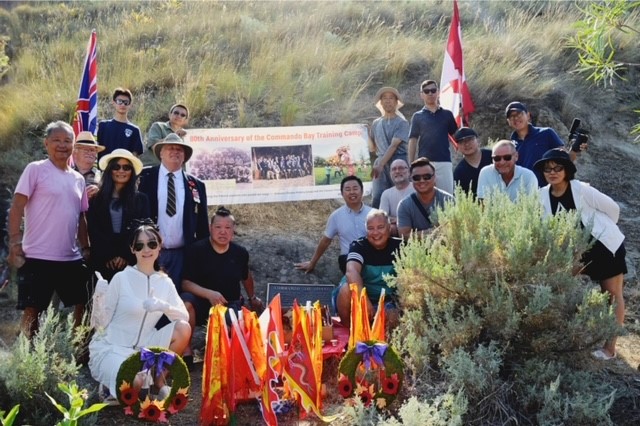On July 18, 2024, the Kelowna Chinese History Group and the Chinese Freemasons of Kelowna partnered to host a visit to the training camp at Commando Bay on Okanagan Lake. This camp existed for only a few months from May to September 1944, as part of Canada’s contribution to the British Intelligence’s Special Operations Executive (SOE). Camp X in Ontario was Canada’s spy school to train civilian operatives for work behind enemy lines to undermine Nazi German domination in Europe. Similar work was performed behind the Imperial Japanese line in Southeast Asian occupied territories during Operation Oblivion with Force 136. Thirteen Chinese Canadians that had volunteered for service in the Canadian Army were recruited and seconded to the SOE for training in Canada. The remote Goose Bay on Lake Okanagan became their training camp for instruction in close combat with small arms, hand to hand combat, radio communications, water and bush craft, and demolitions. They tested their skills by infiltrating and capturing a coastal artillery fortress on Yorke Island in the Johnson Strait protecting Vancouver, and they attempted to attach dummy magnetic mines to ferries at Victoria.
After departing Canada for Australia, they took parachute training near Melbourne to prepare them for insertion into the jungles of the occupied areas in Malaya and Borneo. The intention was for their use of language and cultural skills to infiltrate into the civilian Chinese and Indigenous population of the occupied areas to arm and train local resistance factions to sabotage and disrupt Japanese lines of communications. In early 1945 the task was changed and reduced to assistance in the repatriation of prisoners of war and internees in remote camps, and maintenance of local governance after the Surrender of Japan August 1945. Not all the Imperial Japanese Army stood down in remote areas as communications delayed the transmission of orders. The Allies feared retaliation against prisoners, internees and local populations during the transition. Four men who parachuted into the jungles of Borneo earned the Military Medal for action in Borneo.
| LT. COL. Francis W. KENDALL | Commanding Officer |
| Roy Sin Twe CHAN MM | George Thomas LOCK |
| Roger Kee CHENG | Norman Mon LOW MM |
| Edward CHOW | Raymond Young LOWE |
| Douglas JUNG | James D. SHUI MM |
| John Ko BONG | Henry A. WONG |
| Louis Yee KING MM | Norman D. WONG |
| Wing Yee WONG MM |

Commemorative plaque installed 17 Sept. 1988 Photo by K Boehmer
By October 1945 there were several groups of Chinese and Japanese Canadians in Australia. Since the men were Canadian soldiers working for British Intelligence with the Australian Army, the Canadian Army had no knowledge of the deployment and therefore no role in their repatriation to Canada. Their passage home was at the expense of the men working on cargo ships such as the SS Kitsilano Park. A response to the discriminatory attitudes and policies, and their imposed social position and status during their service was: ‘We’re good enough to risk our necks [for Canada], but we aren’t good enough to live here, to swim in a public pool, sit in the front rows in movie theatres, to have a family, or to vote?’
Goose Bay became known as Commando Bay after the war and on 17 September 1988 a ceremony marked the installation of a bronze plaque and the designation as a heritage site to commemorate their training and achievements. Voluntary and compulsory service in Canada’s Forces during the Second World War by many minorities strengthened their call for equal citizenship in Canada after the war. This was achieved with the implementation of the Canadian Citizenship Act 1946/7 that clarified the definition of a Canadian, nationality at birth, etc., and extended the right vote in all levels of government across Canada especially in British Columbia and Saskatchewan that had withheld those rights. By 1951 all other forms of restrictions and discriminatory policies were removed. February 1947, over 400 Chinese Canadian men and women veterans celebrated their citizenship status as well as access to many professions and programs previously denied them.

A ceremony marked the 80th anniversary of their training and accomplishments on 18 July 2024. Photo by Bowen Tan
In attendance l>r, back >front:
Lee Guan [BC flag], Wentao Guan, Juitang Liu, Shang Zhu [Canada flag], Shawn Gu [camera];
Shuan Boo, Richard Smith, Annie Luam, Howard Hisdal, Renxian Tan, Keith Boehmer, Hayman Lee, Tim Liu, Greg Cole, Hui Ping;
Lina Cai, Shiu Lee, and Ron Wing Fong.
References:
1] The Dragon and the Maple Leaf, Chinese Canadians in World War II, Marjorie Wong, Pirie Publishing, London, Ont. 1994, pgs. 115-117,123-140.
2] Forgotten Yorke Island, History from the Second World War, Michaela Ludwig, June 29, 2019, British Columbia Magazine https://www.bcmag.ca/forgotten-yorke-island/ accessed 12 Sept. 2024
Other sources:
41st Okanagan Historical Report 1977, Commando Bay, Debra Faraguna, pgs. 85-89
53rd Okanagan Historical Report 1989, Commando Bay Re-union, Angeline Waterman, pgs. 19-24
Dr. R.H. Roy, For Most Conspicuous Bravery, a Biography of Major General George R. Pearkes VC through two world wars, UBC Press Vancouver BC, 1977, pgs. 198-202
https://www.veterans.gc.ca/en/remembrance/those-who-served/chinese-canadian-veterans



